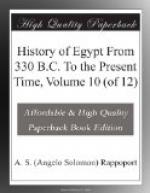Dellius, the bearer of the message, showed that he understood the meaning of it, by beginning himself to pay court to her as his queen. He advised her to go, like Juno in the Iliad, “tricked in her best attire,” and told her that she had nothing to fear from the kind and gallant Antony. On this she sailed for Cilicia laden with money and treasures for presents, full of trust in her beauty and power of pleasing. She had won the heart of Caesar when, though younger, she was less skilled in the arts of love, and she was still only twenty-five years old; and, carrying with her such gifts and treasures as became her rank, she entered the river Cydnus with the Egyptian fleet in a magnificent galley. The stern was covered with gold; the sails were of scarlet cloth: and the silver oars beat time to the music of flutes and harps. The queen, dressed like Venus, lay under an awning embroidered with gold, while pretty dimpled boys, like Cupids, stood on each side of the sofa fanning her. Her maidens, dressed like sea-nymphs and graces, handled the silken tackle and steered the vessel. As she approached the town of Tarsus the winds wafted the perfumes and the scent of the burning incense to the shores, which were lined with crowds who had come out to see her land; and Antony, who was seated on the tribunal waiting to receive her, found himself left alone.
Tarsus on the river Cydnus was situated at the foot of the wooded slopes of Mount Taurus, and it guarded the great pass in that range between the Phrygian tribes and the Phoenician tribes. It was a city half-Greek and half-Asiatic, and had from the earliest days been famed for ship-building and commerce. Mount Taurus supplied it with timber, and around the mouth of its river, as it widens into a quiet lake, were the ancient dockyards which had made the ships of Tarshish proverbial with the Hebrew writers. Its merchants, enriched by industry and enlightened by foreign trade, had ornamented their city with public buildings, and established a school of Greek learning. Its philosophers, however, were more known as travelling teachers than as scholars. No learned men came to Tarsus; but it sent forth its rhetoricians in its own ships, who spread themselves as teachers over the neighbouring coasts. In Rome there were more professors of rhetoric, oratory, and poetry from Tarsus than from Alexandria or Athens. Athenodorus Cordylion, the stoic, taught Cato; Athenodorus, the son of Sandon, taught Caesar; Nestor a little later taught the young Marcellus; while Demetrius was one of the first men of learning who sailed to the distant island of Britain. This school, in the next generation, sent forth the apostle Paul, who taught Christianity throughout the same coasts.




